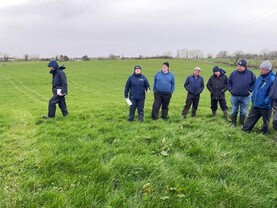Many farmers comparing and pricing winter rations at the moment will have noticed that the inclusion rate of barley has significantly reduced in many cases. This is due to both price and availability. A number of feed merchants are putting the price of rolled barley from €380/t to €400/t currently.
Where farmers are buying in bulk and are speaking to their feed rep, they will often give a detailed breakdown of each ration and its component’s inclusion rates.
Feed companies do not have to supply the exact inclusion rates of each constituent in a ration but they do report them on the feed label, according to their rate of inclusion.
This means that the first item on the list of ingredients has the highest rate of inclusion, working down to the constituent with the lowest level of inclusion, typically the minerals at 1.5% to 2%.
In finishing rations, it is all about energy and so high-quality ingredients such as barley and maize should ideally be at the top of these lists. This year, however, you will see more rations having a high maize component to combat issues around barley.
Maize is an excellent energy source so there is no need to worry about barley moving down the line in terms of inclusion if it is substituted with maize. Look carefully at feed labels to ensure the first three or four ingredients are high-quality.
Feed companies are still likely to have 15% to 20% rolled barley included in finishing rations so any ingredient above barley on the feed list needs to be high-quality as it is a significant proportion of the ration.
I often get asked about wheat and why it is not more commonly included in rations.
It is true that it is an excellent source of energy but the problem is that is highly digestible in the rumen and if the feeding regime is not precisely controlled in terms of timing, diet formulation and access to water it can lead to serious acidosis issues in stock.
Where wheat is used in rations, it is typically at low inclusion levels. This is one of the reasons maize is the preferred alternative to barley as it is much more stable in the rumen of the animal and can be fed at relatively high rates.
Alternative feeds, such as beet, are excellent sources of energy for finishing cattle if the farm is set up to feed it.
The added benefit with beet is that cattle like it so much, you get higher daily intakes so performance is greater than on a similar energy level ration.
There is very little, if any, beet hitting the market just yet so putting a price on it is quite difficult as growers try to maximise yields. However, the price usually tracks the price of barley quite closely in terms of relative feed value.
Every 5kg of beet fresh weight is equivalent to 1kg of rolled barley. Proximity to beet will be a big factor this year in making the decision to feed it or not as haulage costs will have increased significantly from last year.
With fodder shortages in the south and east, it is likely that there will be stiff competition for beet crops, with dairy farms in the best financial position to secure supplies.






 This is a subscriber-only article
This is a subscriber-only article










SHARING OPTIONS: